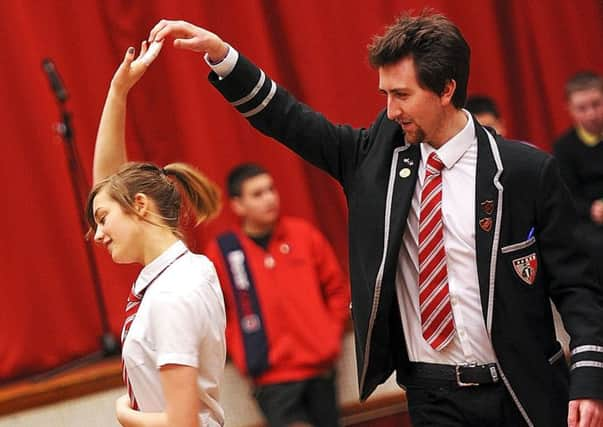Teach Scottish country dancing to children - MSP


As a veteran of Angus village hall hoolies and having jigged to Sir Jimmy Shand’s band in Fife, the Conservative MSP Mary Scanlon had been under the impression she was a dab hand at country dancing.
That was, until she was invited to a charity reels evening in Edinburgh and was embarrassed to discover that she knew the steps to neither the Duke of Perth nor Hamilton House.
Advertisement
Hide AdHer visit to the Reel Difference, a monthly dance at St Mary’s Catholic Cathedral, saw her being cajoled through the dances by expert performers.
As she proffered her right elbow to give her partner an old-fashioned “birl”, she was surprised to be greeted by male dancers with crossed hands preparing to give her an elaborate “twirl” – as practised by the county set. As the melodious Clappy Doo dance band sounded the final chord to signal the end of Hamilton House, Ms Scanlon decided that she’d had enough.
She grabbed her hat, coat and gloves and headed for the door before the dancers took their partners for the Reel of the 51st and the Duke and Duchess of Edinburgh.
“With my background in Angus, I know the Gay Gordons, the Eightsome Reel, the Dashing White Sergeant, Strip the Willow and the St Bernard’s Waltz,” Ms Scanlon told The Scotsman.
“But nothing had prepared me for these wonderful dances that I hadn’t even heard of. The other dancers were very nice and helpful, but I was quite embarrassed and felt quite upset that I was so unfamiliar with all those dances.”
The realisation that her country dancing repertoire was incomplete has led the MSP for the Highlands and Islands to embark on a crusade for Scottish dancing to be taught in all the nation’s schools.
Advertisement
Hide AdShe has tabled a parliamentary question at Holyrood to find out how much country dancing is taught in Scottish schools. Reels are taught in some schools, but Ms Scanlon’s view is that teaching all children to do reels will pay dividends socially and help pupils to keep fit.
“I am starting a new campaign, because I want to get these dances taught in state schools – in all schools,” she said. “I am campaigning for everyone in Scotland to learn these wonderful Scottish dances.”
Advertisement
Hide AdShe added: “I asked people who were high up in the SNP government like Mike Russell, Derek Mackay and Alex Neil if they could do the Duke of Perth or Hamilton House and I just got a vacant look.
“That reassured me that I wasn’t the only one that couldn’t do them. The few MSPs that were familiar with these dances tended to have a background in private education.
“I thought that Scottish country dancing would be in the realm of the working class but when I looked up several websites, I saw that they seemed to be the preserve of the Ross-shire Ball, the Aboyne Ball, the Perthshire Ball, the Northern Meeting and the Angus Ball, where anyone with a working-class background would be totally out of place.”
A Scottish Government spokeswoman said: “Dance, including country dancing, is taught in many schools. Like other dance styles, it helps pupils build movement skills, confidence and enhances physical wellbeing. It also provides an opportunity to reflect on our culture and heritage and gives basic dance skills to fall back on in celebrations that include our traditional dance.”
Casting off, PoWs and teapots: a dancing guide
The “Duke of Perth” is a popular dance during the Highland Ball season and is often known by its alternative title of the Broun’s Reel when it is danced in Angus. The steps involved are the classic pas de basque, partners’ “casting off” before dancing to their “corners” and the “reel of three” or figure of eight.
Some of the more tolerant ball committees will allow the less advanced sets to dance the simpler “Strip the Willow” alongside the Duke of Perth, as the music is a good fit for both dances.
Advertisement
Hide Ad“Hamilton House” is a firm favourite at many balls and there is often much discussion about its origins. Unusually, the dance begins with the first lady dancing to one man before turning another.
Some people believe this reflects an old story about a lady rejecting one man before going off with another. A more likely explanation is that it alludes to the peculiar succession of the earldom of Selkirk.
Advertisement
Hide AdIf the Duke of Hamilton, head of the house, has a younger brother, the earldom passes to the latter rather than to the duke. The dance represents the old Duke’s widow dancing with the new Duke before turning the new Earl – the younger brother.
The “Reel of the 51st” is a more modern dance, but perhaps has the best story of all. Danced to the classic pipe march “The Drunken Piper”, it was invented by soldiers of the 51st Highland Division while incarcerated in a Prisoner of War camp during the last war. A feature is the St Andrews Cross, which is formed by the dancers.
The Duke of Duchess of Edinburgh is one for the real devotee. It is a complicated dance that much practice and is almost impossible to explain – save that it involves several “teapots”, a term used to describe the postures of a group of three dancers who whirl around together.
SEE ALSO